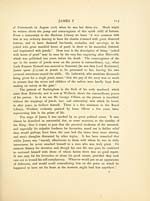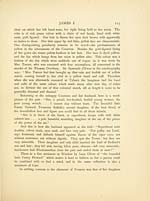Stuarts
(150) Page 114
Download files
Complete book:
Individual page:
Thumbnail gallery: Grid view | List view

ii 4 THE STUARTS
How true this is becomes apparent when we reflect upon the influence
wielded over the King by George Villiers and Robert Carr ; and if Buckingham
was unworthy of the signal honours heaped upon him, what shall be said
of Somerset, with his pink cheeks and womanish complexion, his blue eyes
and auburn hair? What was thought on the subject by his contemporaries
may be gleaned from the following passage :
" This ungrateful Prince (James I.) called up Robert Carre from a poore
page, and, to the dishonour of our ancient nobility, raised him to as high a
title and to as great an estate (three hundred thousand pounds being rated
to the crown upon his fall) as most Earls of England.
" But what have the Scots of their own growth but eggs, barnicles, and
such drugs for the cure of her jaundice as may be found under our hedges.
The Scotch being like horse-leeches on him (James) till they could get no more."
In the Picture Gallery of the Bodleian Library at Oxford is a capital
portrait by Janssen of a man with a most engaging and intelligent face,
with dark hair, dark grey eyes, and a pure fresh complexion. It is that of
Sir Thomas Overbury, who introduced the handsome young Scotchman to
the King. By reason of Carr's complicity in the murder of the poet, his
name was, and ever will be, branded with infamy. The story of the poison-
ing of Overbury, with its sordid details and its revelation of superstition and
crime, has often been told. But no account, however slightly sketched, of
the friends and foes of the Stuarts of this period would be complete without
some reference to Robert Ker, or Carr, to his partner in guilt, and to their
victim. It is a blot upon the memory of James that he spared the lives of
the guilty pair, and even allowed Somerset a pension of ^4000 a year. By
shameless means Lady Frances Howard obtained a divorce from her husband,
the Earl of Essex (whom we shall meet again in the succeeding reign), in
order to marry Carr. It should be remembered that she was but thirteen
when she was married to Essex. The beauty of this unscrupulous, credulous,
wicked woman is admitted on all hands ; some idea of her appearance may
be gathered from the fine painting owned by Mr. Charles Butler, ascribed
to Marc Gheeraedts. This picture was described as Isabella Clara Eugenia,
Infanta of Spain, and Governor of the Low Countries. It was sold at the
Blenheim sale in 1S86, when it fetched 340 guineas. I believe Mr. Butler
got it from Mr. Baring some years later. This very interesting work merits
a short description. The figure is full length, life size, the face nearly full,
looking to the spectator's left. She stands on a Persian carpet, by a crimson
How true this is becomes apparent when we reflect upon the influence
wielded over the King by George Villiers and Robert Carr ; and if Buckingham
was unworthy of the signal honours heaped upon him, what shall be said
of Somerset, with his pink cheeks and womanish complexion, his blue eyes
and auburn hair? What was thought on the subject by his contemporaries
may be gleaned from the following passage :
" This ungrateful Prince (James I.) called up Robert Carre from a poore
page, and, to the dishonour of our ancient nobility, raised him to as high a
title and to as great an estate (three hundred thousand pounds being rated
to the crown upon his fall) as most Earls of England.
" But what have the Scots of their own growth but eggs, barnicles, and
such drugs for the cure of her jaundice as may be found under our hedges.
The Scotch being like horse-leeches on him (James) till they could get no more."
In the Picture Gallery of the Bodleian Library at Oxford is a capital
portrait by Janssen of a man with a most engaging and intelligent face,
with dark hair, dark grey eyes, and a pure fresh complexion. It is that of
Sir Thomas Overbury, who introduced the handsome young Scotchman to
the King. By reason of Carr's complicity in the murder of the poet, his
name was, and ever will be, branded with infamy. The story of the poison-
ing of Overbury, with its sordid details and its revelation of superstition and
crime, has often been told. But no account, however slightly sketched, of
the friends and foes of the Stuarts of this period would be complete without
some reference to Robert Ker, or Carr, to his partner in guilt, and to their
victim. It is a blot upon the memory of James that he spared the lives of
the guilty pair, and even allowed Somerset a pension of ^4000 a year. By
shameless means Lady Frances Howard obtained a divorce from her husband,
the Earl of Essex (whom we shall meet again in the succeeding reign), in
order to marry Carr. It should be remembered that she was but thirteen
when she was married to Essex. The beauty of this unscrupulous, credulous,
wicked woman is admitted on all hands ; some idea of her appearance may
be gathered from the fine painting owned by Mr. Charles Butler, ascribed
to Marc Gheeraedts. This picture was described as Isabella Clara Eugenia,
Infanta of Spain, and Governor of the Low Countries. It was sold at the
Blenheim sale in 1S86, when it fetched 340 guineas. I believe Mr. Butler
got it from Mr. Baring some years later. This very interesting work merits
a short description. The figure is full length, life size, the face nearly full,
looking to the spectator's left. She stands on a Persian carpet, by a crimson
Set display mode to:
![]() Universal Viewer |
Universal Viewer | ![]() Mirador |
Large image | Transcription
Mirador |
Large image | Transcription
Images and transcriptions on this page, including medium image downloads, may be used under the Creative Commons Attribution 4.0 International Licence unless otherwise stated. ![]()
| Histories of Scottish families > Stuarts > (150) Page 114 |
|---|
| Permanent URL | https://digital.nls.uk/95240851 |
|---|
| Description | A selection of almost 400 printed items relating to the history of Scottish families, mostly dating from the 19th and early 20th centuries. Includes memoirs, genealogies and clan histories, with a few produced by emigrant families. The earliest family history goes back to AD 916. |
|---|

